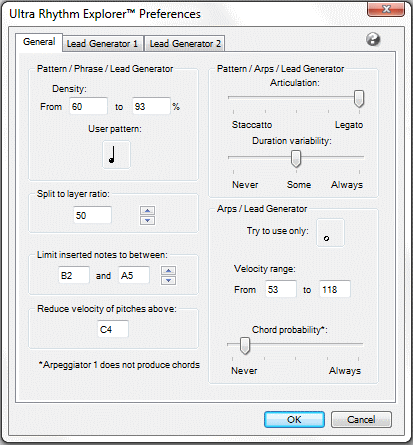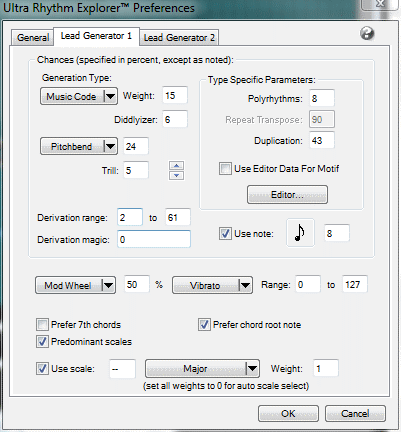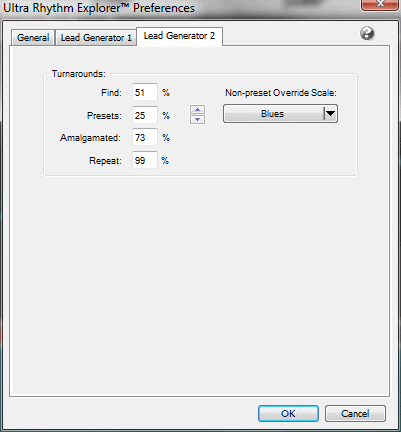Rhythm Explorer Preferences Dialog
General Preferences Tab

Patterns/Phrase/Lead Generator
Use the Pattern Density
fields to tell Rhythm Explorer how dense or "busy" a rhythm you want.
For example, if you want a percussion track to sound more energetic,
you could try values between 80 and 100 percent. If you're after a more
sparse feel, try values between 20 and 60 percent. Use the User Pattern field
to choose the rhythmic placement of notes in the User Pattern choice in
the Algorithms list. For example, if you select a quarter note in the
User Pattern field and then choose User Pattern from the Algorithm
list, all the notes in the User Pattern algorithm will start on a beat,
instead of between beats.
Split to layer ratio
The split to layer ratio sets the chance that any given pattern (when the degree of variability
setting is greater than 1) will be a split as opposed to a layer.
Setting this field to 100 would guarantee that all multi-variability
patterns will be splits. Splits are generated by applying the algorithm
to portions of the selection and then combining those portions. Layers
are created by applying algorithms to the entire selection a number of
times depending on the degree of variability.
Limit inserted notes to between
This sets the range of pitches that will be inserted by the Rhythm Explorer.
Reduce velocity of pitches above
Any inserted pitch equal to or higher than the value entered here will have its velocity reduced.
Patterns/Arps/Lead Generator
In this section you can specify the articulation and the duration variability of the notes generated.
Arps/Lead Generator
This
section allows you to finely control how the arpeggiator patterns or
lead generator notes are generated. Use the note quantize pop-up
menu to tell Metro which note grid lines are to be used. You can
select more than one choice simply by choosing additional note values.
Selected quantizations will display a checkmark. You can also control
the velocity range and the chord probability respectively. Chord
probability has no affect on arpeggiator 1 since it is a single line
arpeggiator.
Lead Generator Preferences Tab 1
More information about the lead generator can be found here.

Generation Types
The
lead generator uses several different generation types. Each will be
chosen based on the weight specified here. The higher the weight the
more likely the generation type will be selected. Currently the
generation types are:
1.Normal
Rhythms are selected based on the 'use note:' field, Pitches are selected based on a multi-delta algorithm.
2.Alternate
Similar to normal, except rhythms are more confined to beat boundaries.
3.Preset
Patterns are generated from the current 'Artist Presets' file.
4.Chordal
Chordal patterns are generated.
5. Music Code
(Formerly
called "LUT") The lead generator generates patterns by
selecting code from a table entry. More info on music code can be
found here.
6.Track Sync
Patterns are generated by synchronizing to a random playing MIDI track.
7. Scale Spiral
Patterns are generated using notes up and down multiple scales. Exotic rhythms can be optionally applied.
Type Specific Parameters
Parameters become available, change or are disabled depending on the current selection of the generation type.
1.Normal
2.Alternate
- Polyrhythms.
The percent specified here determines how frequently the
polyrhythm algorithm is applied to the lead generator pattern. See
"Polyrhythms" below.
- Use notes popup, specified by percent, determines which note quantizations are used.
3.Preset
- Polyrhythms.
The percent specified here determines how frequently the polyrhythms
algorithm is applied to the lead generator pattern. See "Polyrhythms"
below.
- Rhythm. This percent determines how often the rhythm extracted from the Artist Presets file is used.
- Amalgamated. The lead generator combines presets based on the percent specified here.
- Preset
Range. You can specify the range of presets to be used from the
currently selected Artist Preset file. if the 'to' field is set to 0,
the preset range will include all presets from the start value to
the number of presets in the file. Setting the 'from' and 'to' fields
to the same value is useful after adding a preset to the Artist Presets file to verify the quality of the new preset.
- Artist Presets. This button allows you to change the currently selected Artist Presets file at any time.
4.Chordal
- Polyrhythms.
The percent specified here determines how frequently the polyrhythms
algorithm is applied to the lead generator pattern. See "Polyrhythms"
below.
- Use notes popup, specified by percent, determines which note quantizations are used.
5.Music Code
- Polyrhythms.
The percent specified here determines how frequently the resolving
polyrhythms is applied to the lead generator pattern. See "Polyrhythms"
below.
- Duplication. The percent specified here
determines how likely duplication will occur. Duplication causes the
previous beat or few beats to be duplicated. Depending on the density
setting, rests could be placed before the duplication.
- Use
Editor Data for Motif. When this checkbox is checked, the data in the
Music Code Editor will be used wherever a motif is specified in the
song. The editor buffer data is stored with the Metro document but may
not necessarily be saved in the artist presets file.
- Editor... This button leads to the Music Code Editor dialog.
6.Scale Spiral
- Polyrhythms.
The percent specified here determines how frequently the resolving
polyrhythms is applied to the lead generator pattern. See "Polyrhythms"
below.
- Exotic Rhythms. The percent specified here
determines how frequently rational numbers are multiplied by the
current quantize to create more uncommon rhythms. For example,
quintuplets.
Polyrhythms
Every
generation type contains a polyrhythms percent. Polyrhythms are
generated by creating a portion of a lead generator pattern that
uses a number of notes that are not native to their duration. These
notes resolve after a certain number of iterations. For example, 3 16th
notes, when repeated, resolve after 4 iterations.
PitchBend
The
percent chance that pitchbend will be applied is specified here. For
good results the pitch bend range must match the output instruments
pitch bend range.
Trill
The percent chance that trills will be applied is specified here.
Derivation Range
The
percent range that derivation will be applied is specified here.
If the derivation range criteria is met, derivation is applied when a
new lead generator pattern is created. Derivation takes an existing
lead generator pattern and applies a derivation algorithm to
it. The derivation algorithms are currently:
- Change Fixed Position 1
- Change Fixed Position 2
- Change Fixed Position 3
- Change Fixed Position 4
- Change Fixed Position 5
- Split
- Join
- Modify Bend
- Add Members
- Add Member
- Subtract Member
- Add Member Special
- Subtract Member Special
- Rotate
- Reverse Direction
- Copy Last Beat
- Mirror
- Change Pitch
- Change Pitch 2
- Change Pitch 3
- Change Pitch To Octave 1
- Change Pitch To Octave 2
- Swap Pitches
- Change Pitch To Sixth
- Resolve Rhythm
- Change Durations
- Copy And Extend
- Rebuild Durations
- Expand With Random Rests
- Modify Harmony
- Shuffle Beats
Derivation Magic
Derivation
magic specifies which derivation algorithms are used when the
derivation criteria are met. The value specified here is a 32-bit bit
mask. While not user friendly, any combination of the above derivations
can be specified by shifting 1 by the derivation algorithm number above
minus 1 and oring it into the bit mask. For example, if you wanted
"Change Fixed Position 2" (which is 2) and "Copy Last Beat" (which is
16) the calculation would be (where << is a left shift and | is a
logical or):
(1 << (2 - 1)) | (1 << (16
-1)) which equals 1 << 1 | 1 << 15 which equals 2 | 32768
which equals 32770. So 32770 would be entered into the
derivation magic field.
When 0 is specified in this field, all algorithms are selected for derivation.
Controller Section
The
controller section allows you to specify the likelihood, in percent,
that a sequence of controller events will occur in a specified range.
Each controller is independent of the other. Possible controllers
include Aftertouch, Modulation Wheel (1), Breath Controller(2) and
Volume Controller (10). In addition you can specify one of the
following controller algorithms:
- Vibrato
- Filter
- Smart Filter
Scales
The
Lead Generator allows up to 8 override scales to be selected at
one time. Each one can be assigned a weight. If all weights are
specified as 0, the Lead Generator will select scales automatically
based on a randomly selected algorithm, once per Rhythm Explorer
pattern. Scales can be overriden by specifying a scale in the marker edit dialog.
Hovering the mouse over the Rhythm Explorer pattern will show which algorithm was selected. The possibilities are:
| Abbreviation |
Name |
Description |
| "I.S.S" |
Intelligent Scale Switching |
Switch scales based on which scale has more notes in common with the currently chord. |
| "C.S.A" |
Chord Scale Assignment |
Each chord is assigned a particular scale. |
| "S.P.T" |
Switch by Percent Threshold |
Switch scales when a certain percent threshold is met. |
| "S.S.S" |
Seldom Scale Switching by percent threshold |
Switch scales when a certain threshold, that occurs seldomly, is met. |
| "E.P" |
Every Pattern |
Each Lead Generator pattern is assigned a random scale. |
| "E.P.S" |
Every Pattern Shuffled |
Each Lead Generator pattern is assigned a scale in order. The order of scales is initially shuffled. |
| "E.P.P" |
Every Pattern Percents |
Each Lead Generator pattern is assigned a scale based on the weighting. Only used if scales have weights. |
Prefer 7th Chords
When this item is checked, the lead generator will be more likely to use 7th chord tones when creating chords.
Prefer chord root note
When this item is checked, the lead generator will choose the chords root note more often than not.
Predominant scales
Lead Generator Preferences Tab 2

Turnarounds are automatically detected by the lead generator. When a turnaround is found, based on the 'Find' parameter a turnaround will be generated.
A turnaround is generated based on the presets, amalgamated and repeat fields. If a preset is not selected, the lead generator will generate the turnaround internally based on the 'Non-preset Override Scale' or one of the override scales if none is specified.
The amalgamated setting
determines if amalgamation is used in the generation of the turnaround
when presets are selected. Amalgamation combines two or more
presets to generate the turnaround.
The repeat setting
determines whether to repeat the same turnaround or generate a new one,
within the Rhythm Explorer pattern, when multiple turnarounds are found.
See Also:
Rhythm Explorer
All and None Buttons
Rhythm Explorer Algorithms
Using the Rhythm Explorer
Lead Generator
|





